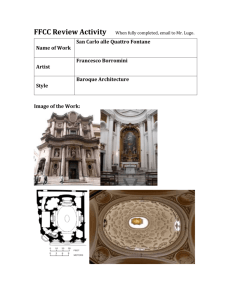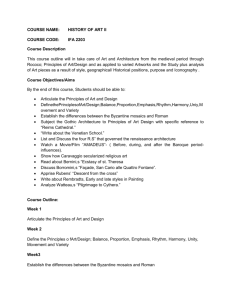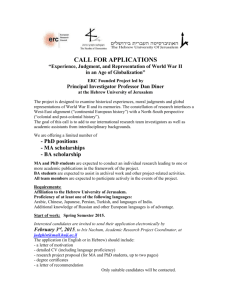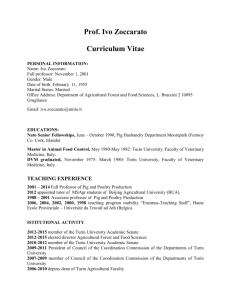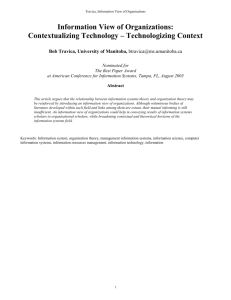File
advertisement
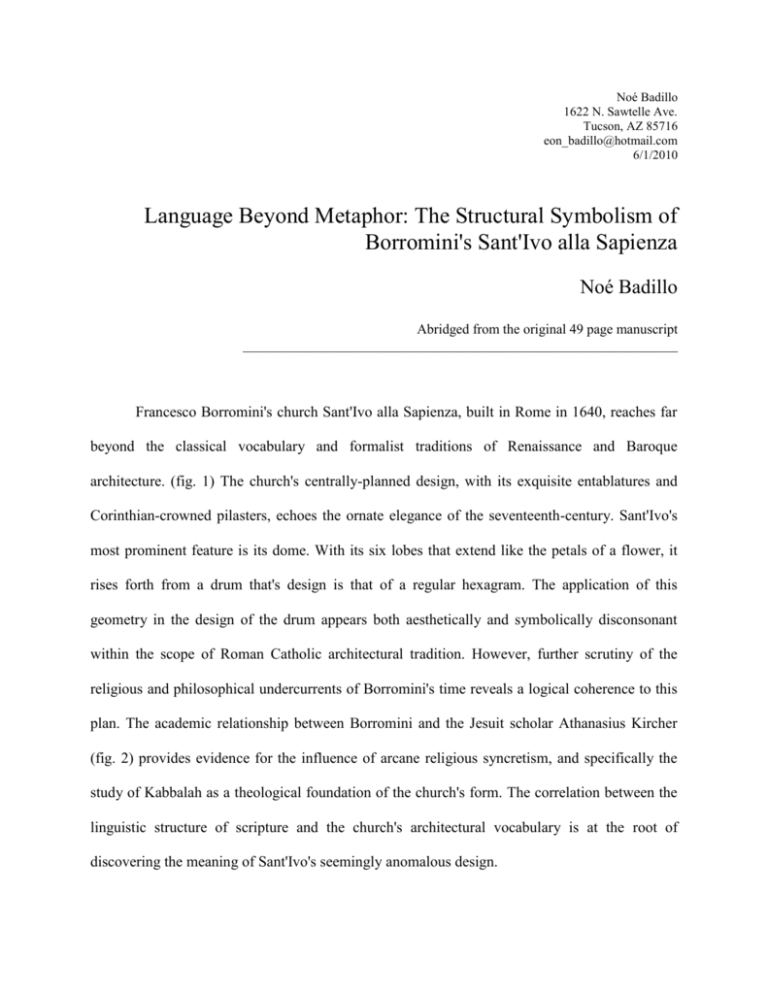
Noé Badillo 1622 N. Sawtelle Ave. Tucson, AZ 85716 eon_badillo@hotmail.com 6/1/2010 Language Beyond Metaphor: The Structural Symbolism of Borromini's Sant'Ivo alla Sapienza Noé Badillo Abridged from the original 49 page manuscript _______________________________________________________________ Francesco Borromini's church Sant'Ivo alla Sapienza, built in Rome in 1640, reaches far beyond the classical vocabulary and formalist traditions of Renaissance and Baroque architecture. (fig. 1) The church's centrally-planned design, with its exquisite entablatures and Corinthian-crowned pilasters, echoes the ornate elegance of the seventeenth-century. Sant'Ivo's most prominent feature is its dome. With its six lobes that extend like the petals of a flower, it rises forth from a drum that's design is that of a regular hexagram. The application of this geometry in the design of the drum appears both aesthetically and symbolically disconsonant within the scope of Roman Catholic architectural tradition. However, further scrutiny of the religious and philosophical undercurrents of Borromini's time reveals a logical coherence to this plan. The academic relationship between Borromini and the Jesuit scholar Athanasius Kircher (fig. 2) provides evidence for the influence of arcane religious syncretism, and specifically the study of Kabbalah as a theological foundation of the church's form. The correlation between the linguistic structure of scripture and the church's architectural vocabulary is at the root of discovering the meaning of Sant'Ivo's seemingly anomalous design. The architectonic relationship between language and structure is an aphoristic concept; one in which grammar and vocabulary act as descriptive elements through which an edifice is interpreted. In understanding the nature of the ecclesium, the language of architecture becomes philogenetically rooted in religious scripture. The theological foundations of Sant'Ivo alla Sapienza point to a transpositional element that exists between the linguistic structure of scripture and the construction of architectural spaces. One in which sacred language becomes both the ideological and the architectonic root from which the church is manifest. The epistemology of Sant'Ivo is forged from Biblical knowledge in a manner that is beyond surface description or historicity. It is one that pertains to a structural and symbolic interlocking of architectural form and cosmology that is archetypally expressed by its central design. The design and fabrication of Sant'Ivo began during the late Counter-Reformation; a time when Renaissance scholars were exploring religious universalism through such ideas as NeoPlatonism, Hermetecism and Kabbalah. The etymology of Catholicism has roots in the Greek adjective καθολικός (katholikos), which is also a contraction of katà hólou, which means "according to the whole". The study of Kabbalah in particular, also tied back to Orthodox notions which emphasize the fundamental importance of the Old Testament as the word of God rather than merely a book of historical significance.1 This Orthodox principle is manifested within Sant'Ivo, as the church is connected to the Old Testament wisdom of King Solomon as a prefiguration and foundation of Christ. It becomes evident in our investigation of Sant'Ivo that underneath the church's surface exists a transposition of scriptural language with the form of the church; in which we discover that the ideological foundation of Christ exists as the very structural foundation of the church. 1 Emil G. Kraeling, The Old Testament since the Reformation (New York: Schocken Books, 1955), 40. Kabbalah is the study of the mystical aspects of Judaism, which originated with a book written four-thousand years ago by Abraham called the Sefer Yetzira, or Book of Creation. The Kabbalah is represented by a symbol called the Ten Sephirot, which represents a cosmology, such as the furthest depth of highest and lowest, the four cardinal directions, and good and evil. The twenty-two letters of the Hebrew alphabet, which coincide with the Sephirot, are believed to form the fundamental structure of the universe. Borromini was a scholar of such arcane seventeenth-century philosophies such as NeoPlatonism and Kabbalah, and had a large library that by the end of his life contained almost a thousand works by authors such as Nicolas Cusanus, Marsilio Ficino, Thomas Aquinas, Plotinus and Plato. These complex theories on the origin of God and the structure of the universe became the theoreticus fundamentum of Borromini's architectural praxis. Within the articulation of forms in Borromini's Sant'Ivo, there is an architectonic complexity of structure and idea that exists simultaneously on multiple planes. According to Cusanus 2 (fig. 3), "the art of logical thought is found in the process of clarifying and making visible the hierarchy of interwoven levels of reality."3 And it is only through a complex examination of the hierarchical concepts of seventeenth-century thought that we can ascertain the ontological significance of his church.4 The interpenetration of philosophical ideas with the church as aedificium is found in the relationship between Borromini's knowledge of craft and design, and within the esoteric theories of Athanasius Kircher. 2 One way in which Kircher's interest in Kabbalah extended to the design fig. 3. Jasper Hopkins, Nicholas of Cusa: Metaphysical Speculations: Vol. II. De Coniecturis (On Surmises), (Minneapolis, Minnesota: The Arthur J. Banning Press, 2000), 183. 3 John Hendrix, The Relation Between Architectural Forms and Philosophical Structures in the Work of Francesco Borromini in Seventeenth-Century Rome (Lampeter, Caredigion, Wales, UK: The Edwin Mellen Press, Ltd., 2002), 108. 4 Nicolas Cusanus was a fifteenth-century polymath who created this diagram to describe an interpolation of the cosmos and humankind, and how we exist in a world in which light and darkness, and oneness and otherness coincide. The transmutation of elements applies to the interlocking of spiritus and materia. And it is this idea that is crucial in understanding Sant'Ivo, and, as we will see, the diagram resembles the hexagrammatic design of the church's dome. of architectural spaces lies within his treatise on sound production entitled, Phonurgia Nova. It is evident in comparing Borromini's Opus Architectonicum5, (a book that includes engravings of all of his major architectural projects) that his study of acoustics within oval-shaped rooms is taken directly from chapter five of Phonurgia Nova, in which Kircher describes in detail the behavior of sound within ellipses and parabolic spaces.6 Kircher's study of acoustics in chapter one of section two of Phonurgia Nova, entitled Phonurgia Latrica, studies acoustics as it is connected to Kabbalah and the Ten Sephirot. The Ten Sephirot represents ten emanations through which God creates the universe into being. The Sephirot are represented as the Kabbalistic tree. 7 (fig. 4) Kircher discusses how divine energy flows through the "Sephirotic channels", and how through Platonism, the explication of the Ten Sephirot weaves everything together that they constitute; astrology, alchemy and everything that flows to God above. The Ten Sephirot becomes a model through which these different elements exist, and according to Kircher "by which everything is calculated, when in astrologic harmony and dissonance, or the 'music of the universe'".8 Kircher's study of acoustics within architectural spaces expresses the fervent desire to create in accordance with a cosmology that embodies concepts within Kabbalah. And it is the 5 For more information about the connection between Kabbalistic influences in the design of architectonic spaces, see Borromini, Opus architectonicum equitis Francisci Borromini ex ejusdem exemplaribus petitu ... partium lineamentis. (London: Gregg Press), 1963. 6 For further research into Borromini's study of acoustics within oval rooms, and especially in reference to San Carlo alle Quattro Fontane, refer to Leo Steinberg's dissertation, Borromini's San Carlo alle Quattro Fontane, A Study in Multiple Form and Architectural Symbolism (New York: Garland Publishing, 1977), 282. 7 fig. 2, An image of the Ten Sephirot. The Kabbalistic Tree of Life. Keter, Chokmah, Binah, Chesed, Geburah, Tipareth, Netzach, Hod, Yesod and Malkuth, are the names of the Ten Sephirot, with Ein Sof above the Crown of Keter. These concepts are discussed later as well in the sections Gematria and Structure, Geometry and Cubits. 8 Athanasius Kircher, Phonurgia Nova: "Varias hujus prodigiosæ curae rationes & caufas varii affignant. Cabaliƒtæ more fuo omnia canalibus fephiroticis, quibus divina vis in fingula mundi influent, attribunt. Modum verò quo hoc fieri afferunt, diximus in Oedipo noƒtro Ægyptiaco tractatu de explicatione arboris 10. Sephiroth; Platonici more fuo horum mirabilium effectum caufas in mundanæ animæ harmonicis omnia fibi copulantis (quam & Colchodeam vocant) nexibus conftituunt; Astrologi & Alchimiƒtæ omnia influxibus fuperiorum corporum attribuunt; quorum omnium fationes, cùm in Aƒstrologia Conƒoni & Diƒƒoni, five in Muƒica Mundana tractaverimus, eò Lectorem remittimus.", 194. study of these ideas that directly influences Borromini, as in his designs of oval-shaped rooms in his Opus Architectonicum. As such, Borromini's method of architectonic expression embodies arcane mystical concepts. The hexagrammatic structure of Sant'Ivo makes theological reference to the Seal of Solomon. The six-pointed star that is the Seal of Solomon originates from a legend about King Solomon, which was the design on a signet ring that he received from heaven. The base of the symbol is thought to touch the ground and the tip is thought to touch heaven. The use of the mysterious symbol of the Seal of Solomon as the central design of the church reveals a significant connection to Kabbalah. The grammar and architectural phrasing of Sant'Ivo stems from the cosmological basis of language found in the study of Gematria. In this sense, our inquiry into the "architectural language" of Sant'Ivo is much more than a metaphor; it becomes the very substance by which the church is constructed. The central plan of Sant'Ivo is designed around the regular hexagram composed of two interlocking triangles.9 (fig. 5) The original geometric plan is also inscribed by six circles; in the physical structure three sit with their center at the outward points of the downward facing triangle, while three interpenetrate the middle of the same triangle where it is interlocked with the upward facing triangle. The effect of this when it is applied to the drum of the dome is that the form of the regular hexagram is interpolated with outward swinging arcs on the corners and apses at the middle. It becomes evident in Borromini's plan that the design of two interlocking triangles inscribed by circles is symbolically intended to represent the Seal of Solomon transposed upon the Sephirot of the Kabbalistic tree of life. (fig. 6) In this sense, Borromini is revolutionary, not 9 fig. 5. An image looking upward through the drum to the dome of Sant'Ivo. Also, a comparison of the view of the dome to the geometric plan. only in combining two formal elements of design, but in creating a synthesis of two important symbols of Jewish mysticism. To discover the theological importance of this design choice, it is important to examine the historiography of the Seal of Solomon, of King Solomon and of Solomon's Temple, also known as the First Temple of Jerusalem. The Seal of Solomon at Sant'Ivo clearly represents the sapiential significance of the Università di Roma, La Sapienza, on whose campus the church sits. On the left-hand corner of the original groundplan drawing of Sant'Ivo10 (fig. 7), Borromini inscribed passages which exemplified the idea of wisdom; "Sapientia aedificavit sibi domum", "Excidit columnas septem" and "Proposuit mensam suam".11 These passages from the book of Proverbs link the construction of Sant'Ivo to the consecration of a sacred house of wisdom. The book of Proverbs, as well as the book of Ecclesiastes and the Song of Solomon were written by King Solomon, and as such Borromini designed the central dome of Sant'Ivo around his Seal. The application of Solomon's Seal at Sant'Ivo alla Sapienza clearly refers to Solomon as the icon of Old Testament wisdom. In the book of Kings, King Solomon is said to have "carved cherubim and palm trees with open flowers"12 within the first Temple of Jerusalem. Borromini's design of Sant'Ivo is also adorned with alto-rilievo sculptures of palm fronds, Easter lilies and cherubim in architrave pediments, apsidal niches and above the windows of the cupola.13 (fig. 8) The book of Kings also enumerates an intriguing passage about the "inner sanctuary" of the temple where the Ark of the Covenant was kept: "The entrance to the inner sanctuary he 10 fig. 6. Joseph Connors, "Sant'Ivo alla Sapienza, The First Three Minutes". The Journal of the Society of Architectural Historians, Vol. 55, No. 1 (Mar., 1996), pp. 38-57 42. 11 Proverbs 9:1-2, RSV. "Wisdom has built her house, she has set up her seven pillars. She has slaughtered her beasts, she has mixed her wine, she has also set her table." Also, for the same Biblical quote in context of Sant'Ivo, see Paolo Portoghesi, The Rome of Borromini; Architecture as Language. Translated by Barbara Luigia La Penta. (London: Thames and Hudson), 1968, 156. 12 1 Kings 6:35, RSV. 13 fig. 7. Anthony Blunt, Borromini, (London: Penguin Books Ltd., 1979), 120. made doors of olivewood; the lintel and the doorposts formed a pentagon."14 However the Bible notes that the translation of this passage from the original Hebrew is "obscure". In another older Hebrew translation of the Old Testament, the passage reads simply that "the lintel and side posts were a fifth part of the wall."15 The book written by Athanasius Kircher entitled Oedipus Aegyptiacus, also contains a section on the Kabbalistic significance of "the six-pointed star, which he refers to by the name 'Sigillium Salomonis'". In this chapter, he mentions that "the five-pointed star is likewise a talisman called the 'Seal of Solomon'."16 It is perhaps for this reason that the biblical transliteration of "pentagon" in describing Solomon's Temple has remained in obscuritas, while it might have actually represented something of a secret symbol that is not actually a pentagon but something between a pentacle and a hexagon, or the Seal of Solomon itself. As this pentagonal structure is the entrance to the inner sanctuary of the Temple of Jerusalem, the Holy of Holies, it holds a clue to the significance of Borromini's Sant'Ivo as a sacred temple of wisdom, rooted in the Old Testament theology of King Solomon. In searching for the hidden design of this inner sanctuary, it becomes evident that there is something further to be revealed within the linguistic structure of the Bible. There is a deeper ontological layer that exists within the fabric of sacred languages that becomes a bridge between the word as a simple term of description, and the Word as an element of cosmological structure. By transposing of the Seal of Solomon and the Sephirot in the design of Sant'Ivo, Borromini creates a design that is not only symbolic, but also cosmological. Both symbols represent a cosmographum; that is, they point to the first and last of creation, the highest and 14 1 Kings 6:31, RSV. Alexander Harkavy, The Holy Scriptures, Revised in Accordance With Jewish Tradition and Modern Biblical Scholarship, (New York: Hebrew Publishing Co., 1936), 1 Kings 6:31. 16 Pierre de la Ruffinière Du Prey, "Solomonic Symbolism in Borromini's Church of S. Ivo alla Sapienza", Zeitschrift für Kunstgeschichte, 31 Bd., H. 3 (1968): pp. 216-232, 224. 15 lowest point, and the four directions. However, the Sephirot also represent the promulgation of the universe through language. Through this, we arrive at an understanding of language that is beyond a mere method of description; it is the fundamental structure of the universe. It is this understanding of language that is spoken of in the Sefer Yetsira of Abraham. As applied to Sant'Ivo, the "architectural language" of the church is not only a descriptive metaphor. Its structure reflects, embodies, and exists as the design of the universe. Living language, in the most primordial, fundamental sense is what Sant'Ivo is made of. The linguistic concept in Kabbalism that integrates the transposition of language and creation is known as Gematria, which involves the understanding of Hebrew17 words or phrases according to their numerical attribution. Each letter of the Hebrew alphabet contains a certain numerical value, which is often represented by a chart called the Autiot,18 (fig. 9) which means "signs." The Autiot "outspreads their specific function as constituents of an alphabet."19 The numerical attributions of Hebrew letters are used in esoteric exegetical practices of reading Hebrew scripture. Hebrew words are constructed of very specific combinations of letters, that are meant to represent the physical and metaphysical structure of the object that they describe.20 The Hebrew language thus represents both a structural as well as a causational principle. As the Hebrew language is structural, it is also thus projectional; Hebrew, as a causational principle forms a projectional geometry into space that is fundamental and symbolic. 17 Gematria also exists in the Greek Alphabet, but it is of greater significance within this paper, because of the focus on the Old Testament and Kabbalistic study of Sant'Ivo, to deal mainly with the Gematria of the Hebrew alphabet. For more research into Greek Gematria, see The Apostolic Gnosis, and Gematria by Simcox Lea & Bligh Bond. 18 fig. 8, from Carlos Suarès' The Song of Songs, The Canonical Song of Solomon deciphered according to the original Code of The Qabala. (Berkeley, CA: Shambala Publications), 1972 "The Cipher of Genesis" shows the numerical value of each Hebrew letter. 19 Bond F.R.I.B.A., Frederick Bligh and Lea D.D., Thomas Simcox, Gematria. A Preliminary Investigation of The Cabala contained in the Coptic Gnostic Books and of a similar Gematria in the Greek Text of the New Testament. (Wellingborough, Northamptonshire: Thorsons Publishers Limited), 1977, 12. 20 This is similar linguistically to the featural alphabet, in which the physical structure of the letter expresses the phonemes by which the word is vocalized. However, there is difference in the cosmological significance of Hebrew, as the letters of the alphabet are thought of as the actual constituents that form the universe. (fig. 10) The concept of projective geometry originates in the third century AD with Pappus of Alexandria, and later in the quattrocento with Filippo Brunelleschi. Later advancements in the sixteenth-century with Johannes Kepler and Gérard Desargues involved the projection of space at infinite distance from a vanishing point. The interest in projectional geometry during the Renaissance provided the mathematics behind perspective art. Projective geometry is invariant under projectivity, meaning that as the geometric form is seen from different angles, the form does not change. This is why projective geometry becomes vital during the Renaissance in perspective drawing and architecture, and is a basis of Euclidean geometry as well, although it, in itself is non-Euclidean. Projective geometry becomes important in our investigation of the Hebrew language, as Hebrew becomes projective through harmonic quadruples, which is an essential part of Desargues' theorem. Applied to Sant'Ivo, the projectional aspect of language can be thought of as the relation between the symbol and the archetype of the Solomonic Seal and the Sephirot, with the spatial dimensions of the church. The cosmological idea within the central design of the church becomes the direct causation of its design and form. In Matityahu Glazerson and Zeev Manevich's book The Geometry of the Hebrew Alphabet, (fig. 11) the Hebrew language is described as a projection from God to the base of Mt. Sinai, where the Torah was received. Glazerson believes that the Hebrew alphabet contains three properties, "number, form and idea";21 the number being the Autiot, the form being the fundamental structure of things, and the idea being its Kabbalistic attribution to certain theological principles. The point and the line are the two fundamental principles from which all geometry is generated. In the Hebrew language a point is represented by "Yod" ()י, and line by "Vau" ()ו. Within the geometry of the twenty-two letters of the Hebrew alphabet, there are seven 21 Matityahu Glazerson and Zeev Manevich, Geometry of the Hebrew Alphabet, (Jerusalem: Yerid Hasefarim Publications, 2002), 52, 54. points that exist within the shapes of the other letters. There are also seven points that exist within the Solomonic design of Sant'Ivo, including the center. Amongst all of the projective correspondences of the Hebrew alphabet, the most possible combinations of Gematria are contained in the phrase representing the receiving of the Torah on Mount Sinai by Moses, which also includes the instructions to build the Ark of the Covenant. The Ark was housed in the First Temple of Jerusalem where we also found the Seal of Solomon hidden in its design. When this phrase, which in Hebrew is בכר-( איik-bahar),22 is put on a canonical cross section, or in other words, if the projective geometry is fixated around a circle, the combination of Hebrew characters forms the interlocking triangles of the Seal of Solomon. Solomon's Seal is a recurring archetypal symbol, present from the receiving of the Torah, which contained the instructions for building the Ark of the Covenant, which was housed in the First Temple of Jerusalem where Solomon's Seal also appears, to the drum of the dome of Sant'Ivo. In relationship to Borromini's Sant'Ivo alla Sapienza, the use of Solomon's Seal as the central design around the drum of the dome exists as an oracle through which an integral relationship with God exists in the utmost sense. This can also be understood through the Platonic concept of εiδος, the idea of "a substantial form which is unchangeable in nature",23 which is also described by Neo-platonic philosophers such as Gottfried Wilhelm Leibniz as the materia prima. The subject of eidos describes the idea of form which embodies a manifested structure of reality that is beyond transitory states. It is a form that is connected to an aspatial and atemporal existence (the source of causation); thus as it manifests in reality, its visual φαινόμενα (appearance) has an infinite and archetypal root. Sant'Ivo alla Sapienza is an edifice which contains this archetypal root. The 22 23 fig. 9. Glazerson and Manevich, Geometry, 69. ibid., 103. substance of the church, beyond stone and mortar, is made of the materia prima, the prime matter by which the universe itself is constructed. It is by this that Borromini as architect manifests what Plato calls a "visible and tangible heaven".24 It is the Word (fig. 12) manifested as creation that forms an intercursus between the learned study of sacred scripture and the knowledge contained therein, allowing the architect and mason to design the structure of the church according to the word by which God created the world, in order to make manifest a holy and consecrated edifice out of that which does not appear,25 and by making the unseen seen. It is in this that the language of architecture is exemplified beyond aphorism, as it is this cosmological understanding of language that is the very structure by which all things exist. Sant'Ivo alla Sapienza is an instrument, meant to facilitate this divine relationship through the intricacies of its features. The architect is "ordained by God to create a second universe."26 The scriptural basis of Sant'Ivo within the book of Kings exists beyond the surface of Biblical understanding; it exists as the very fabric by which it was created. Francesco Borromini's church is the embodiment of an architectonic language that is beyond the metaphor of description. Sant'Ivo alla Sapienza reflects the divinity by which God designed the cosmos. . 24 quoted in Hendrix, Architectural Forms, 65. Hebrews, 11:3, "By faith we understand that the world was created by the word of God, so that what is seen was made out of things which do not appear." 26 Hendrix, The Relation Between Architectural Forms, 206-207. 25 Bibliography Blau, Joseph Leon. The Christian Interpretation of the Cabala in the Renaissance. New York: The Columbia University Press, 1944 Blunt, Anthony. Borromini. London: Penguin Books Ltd., 1979 Bond F.R.I.B.A., Frederick Bligh and Lea D.D., Thomas Simcox. Gematria. A Preliminary Investigation of The Cabala contained in the Coptic Gnostic Books and of a similar Gematria in the Greek Text of the New Testament. Wellingborough, Northamptonshire: Thorsons Publishers Limited, 1977 Materials for the Study of The Apostolic Gnosis. Wellingborough, Northamptonshire: Thorsons Publishers Limited, 1919 Borromini, Francesco. Opus architectonicum equitis Francisci Borromini ex ejusdem exemplaribus petitu ... partium lineamentis. London: Gregg Press, 1963 Sant'Ivo alla Sapienza, ædes acutenses. Roma: Edizione a cura di Alessandro Martini, MDCCXX (1720) Connors, Joseph. "S. Ivo alla Sapienza: The First Three Minutes." The Journal of the Society of Architectural Historians, Vol. 55, No. 1 (Mar., 1996), pp. 38-57 Du Prey, Pierre de la Ruffinière. Revisiting the Solomonic Symbolism of Borromini's Church Sant'Ivo alla Sapienza. Troy, N.Y.: Rensselaer Polytechnic Institute, School of Architecture, 1988 "Solomonic Symbolism in Borromini's Church of S. Ivo alla Sapienza." Zeitschrift für Kunstgeschichte, 31 Bd., H. 3 (1968), pp. 216-232 Editori, Marsilio, ed. Enciclopedismo in Roma Barocca. Venezia: Marsilio Editori S.P.A., 1986 Farmer, S.A. Syncretism in the West: Pico's 900 Theses (1486). The Evolution of Traditional Religious and Philosophical Systems. Tempe, Arizona: Medieval and Renaissance Texts and Studies, 1998 Glazerson, Matityahu and Manevich, Zeev. The Geometry of the Hebrew Alphabet. Jerusalem: Yerid Hasefarim Publications, 2002 Godwin, Joscelyn. Athanasius Kircher. A Renaissance Man and the Quest for Lost Knowledge. London: Thames and Hudson, Ltd., 1979 Harkavy, Alexander. The Holy Scriptures, Revised In Accordance With Jewish Tradition And Modern Biblical Scholarship. New York: Hebrew Publishing Co., 1936 Hendrix, John. Architectural Forms and Philosophical Structures. New York: Peter Lang Publishing Inc., 2003 The Relation Between Architectural Forms and Philosophical Structures in the Work of Francesco Borromini in Seventeenth Century Rome. Lampeter, Caredigion, Wales, UK: The Edwin Mellen Press, Ltd., 2002 Hopkins, Jasper. Nicholas of Cusa. Metaphysical Speculations, vol. II. De Coniecturis (On Surmises). Minneapolis, Minnesota: The Arthur J. Banning Press, 2000 Kircher, Athanasius. Phonurgia Nova. New York: Broude Brothers, 1673 Kraeling, Emil G. The Old Testament since the Reformation. New York: Schocken Books, 1955 Maravall, José Antonio. Culture of the Baroque; Analysis of a Historical Structure. Minneapolis, Minnesota: University of Minnesota Press, 1975 Partini, Anna Maria, Athanasius Kircher e l'Alchimia. Testi scelti e commentati. Rome, Italy: Edizioni Mediterranee, 2004 Popkin, Richard H. and Weiner, Gordon M., ed. Jewish Christians and Christian Jews. Dordecht, The Netherlands: Kluwer Academic Publishers, 1994 Portoghesi, Paolo. Borromini nella cultura europea. Roma-Bari: Gius. Laterza & Figli Spa, 1982 The Rome of Borromini; Architecture as Language. Translated by Barbara Luigia La Penta. London: Thames and Hudson, 1968 Rowland, Ingrid D. The Ecstatic Journey. Athanasius Kircher in Baroque Rome. Chicago, Illinois:University of Chicago, 2000 Steinberg, Leo. Borromini's San Carlo alle Quattro Fontane, A Study in Multiple Form and Architectural Symbolism. New York: Garland Publishing, 1977 Suarès, Carlo. The Sepher Yetsira; Including the Original Astrology According to the Qabala and Its Zodiac. Boulder, Colorado: Shambala Publications Inc., 1968 The Song of Songs, The Canonical Song of Solomon deciphered according to the original Code of The Qabala. Berkeley, CA: Shambala Publications, 1972 Wirszubski, Chaim. Pico della Mirandola's Encounter with Jewish Mysticism. Cambridge, MA and London England: Harvard University Press, 1989

